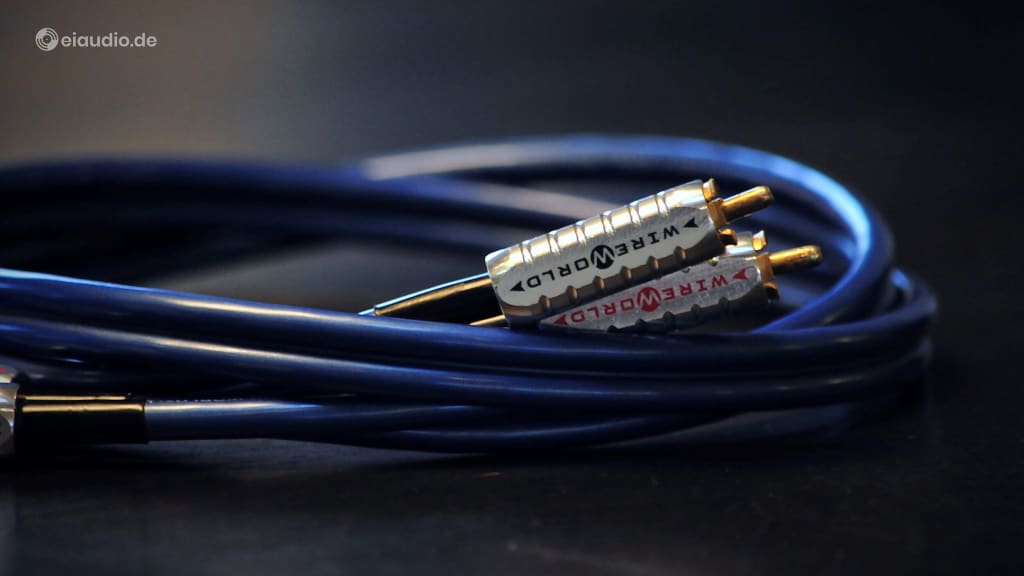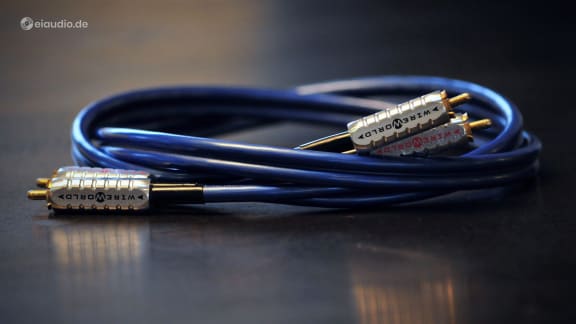Wireworld Luna 7
Published: 04/01/2021
Manufacturing date: 2024
Author: Karsten Hein
Category: Gear & Review
Tag(s): Cables
Wireworld’s Luna 7 is a real lightweight among the entry level audiophile interconnects. However, despite its flimsy feel, it does pack some punch. It features Wireworld’s patented DNA Dual Helix design, which internally consists of two veins of flat cable with two separate and equally spread out strands of 20 OFC copper wires in each. The silver clad aluminium plugs feature low mass gold plated contacts and a hollowed gold-plated centre prong. The two channels are physically joined together in the centre with the outer plastic skin, as is more prominently found on speaker wires. As this goes against all my advice given on this website, I was tempted to pry them apart to improve channel separation, but ultimately decided against it to preserve resale value. Although moderate in price, such a re-design of my own making would be difficult to explain to a future buyer.
I had originally bought this cable to play between our Denon CD player and preamplifier. In this position it only gave a mediocre performance and was soon replaced with more expensive braided interconnects by Kimber. Between CD player and preamplifier, the Luna 7 had sounded rather soft, producing a pleasant but unrealistic halo around the highs and lacking bass attack as well as bass control. Because of its delicate touch and feel, it had simply not occurred to me to test it in any other position. At the time, I had assumed that this was how it sounded and had placed it in my cable box with some disappointment.
Looking at the subject of cables again for the eiaudio.de website, I came across the Luna 7 again. And although two years had passed since I had last heard it, I was surprised that I still had the sonic memory of it. My first impulse was to sell it without trying it again or discussing it here, but then I called my friend and co-audiophile Luigi to discuss some ideas on cable position with him. We both agreed that there were few general rules on how a cable will perform in a given position and that, except for a few exceptions perhaps, to be absolutely sure, each cable should be tested in as many positions as possible to reach a full understanding of its abilities in combination with the given equipment.
Before re-connecting the Luna 7, I had been running a pair of Georg Neumann interconnects with HiCon plugs between preamplifier and power amp on our Restek-Hafler-Tannoy system. The Neumann cables are fast and punchy with a slight edge to them in the highs. They add a bit of drama, which I generally like. I replaced the Neumanns with the Wireworld Luna 7 and was surprised that the halo I remembered did not shine through this time. The Luna 7 still produced a softer sound, but in this new position, the change was not at all unpleasant nor was it unrealistic. While there was sufficient timbre on piano notes, there was also a new delicacy to cymbals. I had read somewhere that the Luna 7 produced a boomy bass, a phenomenon that I was unable to confirm in either position. Bass was not particularly nuanced, this was true. However, it blended in well with the overall picture.
Advert eiaudio/shop:
Voices were perhaps a bit on the light side and appeared to be slightly set back, but they were never unpleasant. Kari Bremnes’ song “A Lover in Berlin” is a good case in point, as the voice can all to easily sound too piercing. This was no longer the case with the Luna 7. Other aspects of the music moved forward and reached further into the room than had been the case with the Neumann interconnects. The Luna 7 would have served well to enhance electronic music, as effects were slightly more pronounced. The soundstage could have been more clearly set and perhaps also more assertive perhaps. The Neumanns had produced a lifelike stage with lots of separation between the instruments. This was not necessarily a strong point of the Luna 7 (unsurprisingly), however, the stage that it did create was rather enjoyable and laid back.
The biggest strength next to its pleasant highs were arguably its price, at which there was little competition at the time (or even now). For those who are interested and wish to purchase new, Wireworld have released updated versions, such as the Luna 8 with a slightly improved DNA double helix design and similar sonic features. Used versions of the Luna 7 are available at very reasonable prices. Both versions have been given favourable reviews by critics and consumers alike.
If the aim of this website is to propagate affordable HiFi solutions that deserve the term ‘fidelity’, this cable should be listed among the available options. I will keep the Luna 7 running for a few days, as I am positively surprised by its performance between preamplifier and power amplifier. Not ‘High End’ but highly enjoyable nevertheless. At this point, I am not sure if I can get over the fact that the two channels are running in parallel with that tiny space of plastic between them, and, after all, there are further cables to be explored. If you are familiar with the Luna 7 or Luna 8 interconnects, you are more than welcome to leave a comment below.
Tested on the following setup: CD player: Denon DCD 1420 (on Digital Coax HiVilux Reference); DAC: Cambridge DacMagic 100 (on Kimber Kable Timbre); Preamp: Restek V1 (on Wireworld Luna 7); Power amp: Hafler XL-280; and Tannoy XT8F (bi-wired, on Belden 9497)
Specifications
- Cable lengths: 100cm
- Longitudinal resistance: N.N.
- Parallel capacity: 300 Pikofarad/m
- Serial Inductance: 0,34 Microhenry/m
- Characteristic impedance: N.N.
- Handling: directional, soft flexible
- Termination: Aluminum (silver & gold plated)
- Position tested: pre to amp





